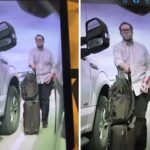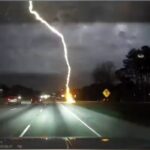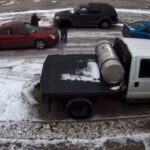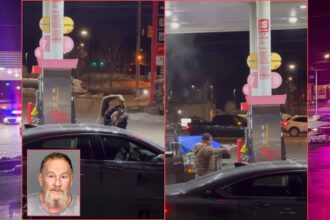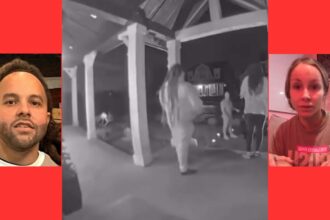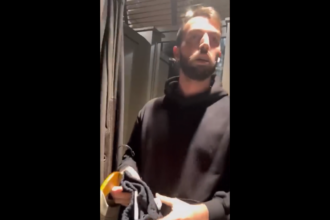LOS ANGELES, CALIFORNIA.— On a recent evening in Los Angeles, the LAFD (Los Angeles Fire Department) responded to a chaotic scene that unfolded during a street takeover event. Street takeovers, which involve drivers gathering to perform reckless stunts, spinning cars in circles, and blocking intersections, have become an increasingly dangerous and disruptive problem in various parts of the city. These gatherings draw large crowds, often leading to dangerous behavior as participants race their vehicles, interact aggressively with law enforcement, and engage in reckless driving maneuvers. This incident, however, escalated beyond the usual burnout, highlighting the severe risks associated with such events not only to the participants but also to innocent bystanders and local residents.
Understanding the Risks of Street Takeovers
Street takeovers have been a growing concern across major cities in the United States, not just Los Angeles. In cities like Miami, New York, and Houston, similar incidents have sparked intense debate about public safety, law enforcement practices, and the cultural implications of car culture among youth. These events often bring together individuals from diverse backgrounds, uniting them through a shared passion for motorsports, but this passion can quickly turn dangerous. Many participants argue that they are simply engaging in a form of entertainment; however, the risks associated with high-speed driving, reckless behavior, and the potential for injury or death cannot be overlooked. Observers have noted that the presence of social media has amplified these events, with participants eager to share their exploits online, further fueling the trend.
Moreover, the community’s response to these street takeovers can vary widely. Some residents may feel a sense of frustration and anger toward the participants, citing noise pollution and safety concerns, while others may view it as an opportunity to engage with local car enthusiasts in a more constructive way. Community-driven events and car shows can provide a safer alternative for individuals looking to showcase their vehicles and driving skills, which in turn can foster a sense of camaraderie rather than conflict. Local governments have begun to explore the idea of designated areas where car enthusiasts can gather and share their passion in a controlled environment, free from the danger posed by street takeovers.
The psychological factors at play in street takeovers are also worth examining. Many young drivers are influenced by a desire for recognition, validation, and belonging. In an era where social media dominates, the urge to capture and share daring stunts can overshadow the inherent risks of such behavior. Young people often underestimate the consequences of their actions, believing that they are invincible in the face of danger. Educators and parents are encouraged to engage in open discussions about the implications of reckless driving and the importance of making responsible choices. Through education and awareness, communities can work together to redirect this enthusiasm for cars and racing into safer, more productive outlets.
As this situation unfolds, it is crucial for everyone involved—community members, law enforcement, and city officials—to come together and address the underlying issues that give rise to street takeovers. Open forums and community meetings can serve as platforms for discussion and collaboration, allowing citizens to voice their concerns and contribute to potential solutions. As society evolves, so too must our approach to public safety, ensuring that the rights of individuals to enjoy their cars do not infringe upon the rights of others to live in a safe and peaceful environment. The hope is that through collective action and understanding, the frequency and severity of such incidents can be reduced, paving the way for a safer future for all.
Ultimately, this incident serves as a call to action for not only the authorities but also community members to take a stand against reckless driving culture. By promoting positive engagement and providing safe spaces for car enthusiasts, cities can cultivate an environment that celebrates automotive passion while prioritizing public safety. It is also essential for law enforcement to approach these events with a balance of firmness and understanding, focusing on education rather than solely punitive measures. This multifaceted strategy may help bridge the gap between law enforcement and the community, fostering a collaborative approach to addressing the challenges posed by street takeovers and creating safer neighborhoods.
The scene started with cars spinning out of control in the middle of the street, blocking traffic, and creating a hazardous environment for anyone in the vicinity. Amid the chaos, a white SUV was seen rolling through the intersection with its doors wide open — notably with no driver behind the wheel. The SUV slowly rolled across the street and collided with a nearby truck, causing significant damage to the vehicle. Onlookers watched as the unattended SUV continued its dangerous roll, narrowly missing pedestrians and other parked cars. Such incidents not only pose physical dangers but also contribute to heightened levels of anxiety and fear among local residents. Emergency calls from witnesses often flood in, leading to a rapid response from law enforcement and emergency services, as the community grapples with the unpredictability of street takeover events.
As the SUV came to a stop, an individual rushed toward the vehicle and hopped into the driver’s seat, taking control of the vehicle. The car, possibly stolen, then sped away down the street. It was unclear whether the driver was part of the initial takeover or had simply taken advantage of the chaos. This incident raises questions about the motivations behind such reckless behavior, as well as the societal issues that drive individuals to participate in illegal street racing and takeovers. Many participants view it as a form of rebellion against authority, while others may see it as a way to gain social media fame or recognition among their peers.
The SUV’s driver didn’t get far. Just a block away, they stopped the car, got out, and set the vehicle on fire. The fire quickly spread, sending thick black smoke into the air, drawing the attention of nearby residents and prompting emergency services to be called to the scene. Setting a vehicle on fire is a dangerous act that not only damages property but also poses a significant risk to human life. Firefighters and police officers often face numerous challenges when responding to such incidents, particularly in densely populated urban areas where uncontrolled fires can spread rapidly and threaten surrounding buildings and vehicles.
The LAFD swiftly responded, extinguishing the blaze and ensuring the safety of bystanders. However, this incident serves as a stark reminder of the dangers posed by street takeovers, which continue to disrupt communities across Los Angeles. The fire department’s response underscores the importance of community awareness and engagement in combating such events. Local citizens are encouraged to report any suspicious behavior or gatherings that may lead to unsafe conditions. Moreover, city officials and law enforcement agencies are working collaboratively to develop strategies aimed at preventing street takeovers, such as increased patrols, public awareness campaigns, and legislation aimed at imposing stricter penalties on participants and organizers of these illegal events.





